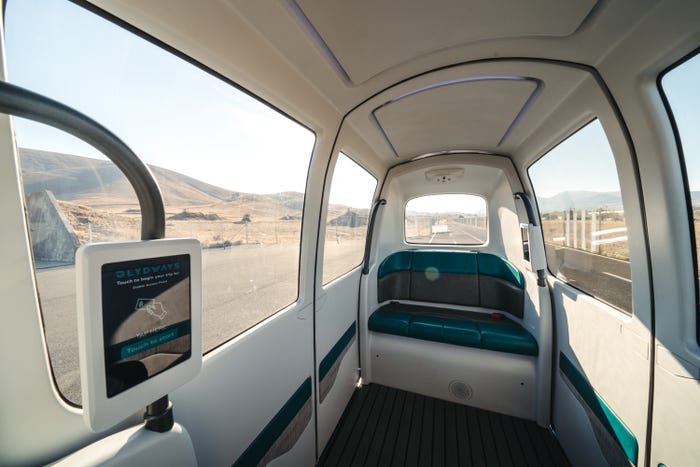Self-Driving Pods to Shuttle Airport Passengers in San JoseSelf-Driving Pods to Shuttle Airport Passengers in San Jose
Glydways’ four-person electric pods would shuttle between San Jose Mineta International Airport and Diridon Station by 2028

Authorities in San Jose, California are considering a radical automated transport system that could prompt a rethink over how autonomous vehicles (AVs) are deployed.
That’s because the personal rapid transit (PRT) system that is being discussed to ferry passengers between San Jose Mineta International Airport and Diridon Station will not use existing roads, but instead require dedicated narrow 5.5-foot-wide paths.
Four-person electric pods, developed by San Francisco start-up Glydways, will shuttle both ways between the airport and the city center on the eight-minute route.

Glydways is part of a consortium led by Plenary Americas – a developer and investor in public infrastructure – that was chosen by San Jose following a request for proposals asking teams how they would work with the City to design, finance, build and operate a new transit line.
More than 20 interested parties replied, including Elon Musk’s Boring Company, which suggested building a tunnel for AVs, and more conventional tram and bus operators. But, in a move that has surprised some, the city has been swayed by the prospect of a solution – as yet unproven – that promises a low carbon footprint and cost savings in comparison to conventional mass transit systems.
Glydways’ pods operate in a “closed” environment – a purpose-built, fenced-off guideway, created exclusively for them – and so are cheaper to produce, because they don’t require the more complicated sensors required by “open-road” AVs. Instead, they use more specific sensors, for localization and communication.
As Mark Seeger, Glydways founder, explained in a post on LinkedIn, there are other differences, too.
“The software is even more nuanced. An open road autonomous vehicle has all of its intelligence on board because it is the sole actor in its journey,” he wrote. “For a closed road system such as Glydways, the reverse is true: a majority of the intelligence sits outside the vehicle (on the infrastructure elements and the cloud).”
In addition, because the roads are closed, operators can monitor them at all times from within the lanes themselves, meaning high-capacity usage can be guaranteed when required. Given that the pods only operate when summoned by an app, this model also delivers excellent efficiency, with no vehicles running when there is no demand.
The proposed system for San Jose is designed to initially carry more than 2,000 passengers an hour in each direction and is likely to cost in the region of $500 million.
However, although it is the recommended solution, it is not yet set in stone. Now the City Council has to decide whether to enter the first phase of a multi-phase agreement to develop the project. This will result in a project feasibility validation report, which will assess the technical, commercial, and financial viability of the proposed solution. A design and environmental study will be required, too.
Should all the necessary hurdles be cleared, local media report that the project could get underway by 2028 – and it’s likely that cities across North America will be watching with interest.
About the Author
You May Also Like








